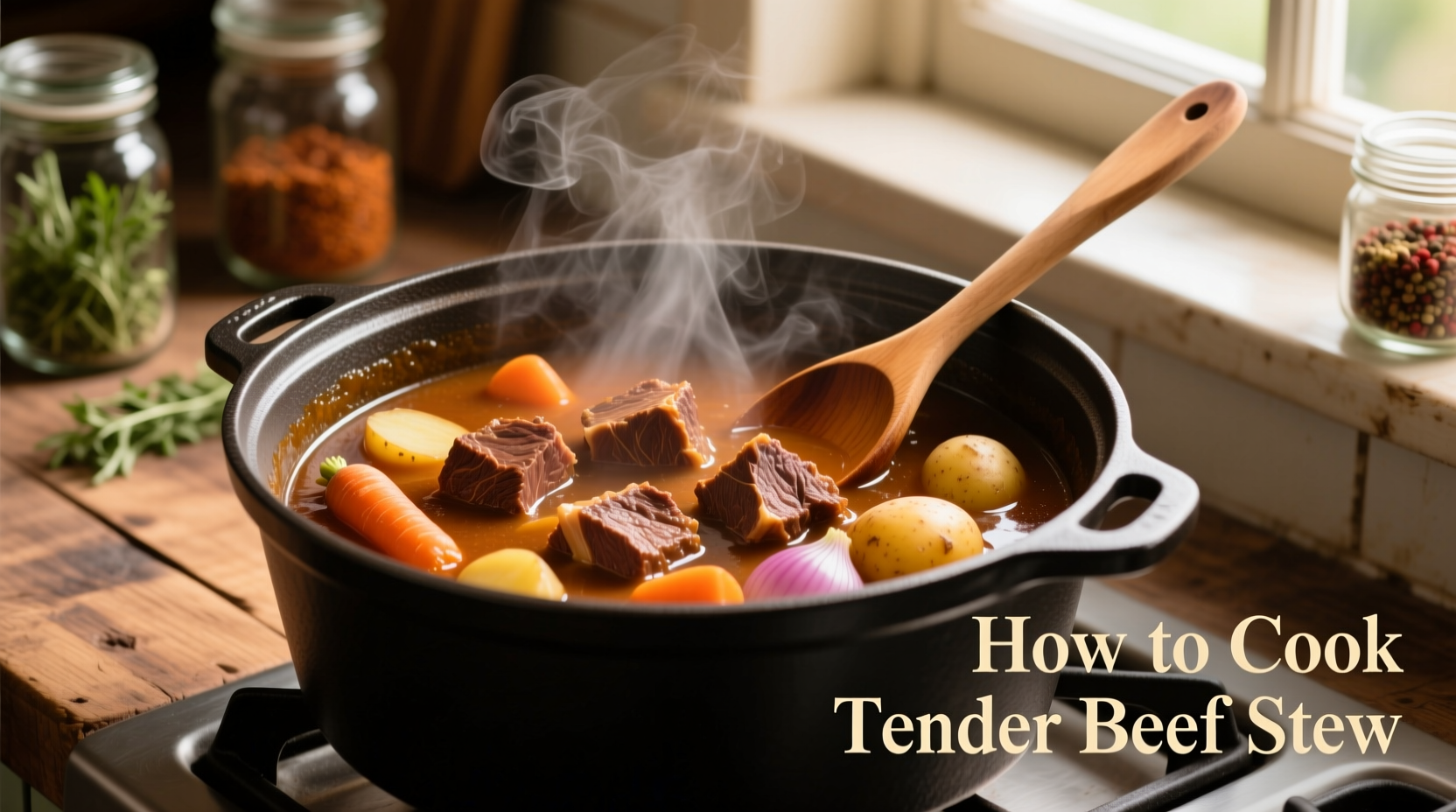For perfectly tender beef stew every time, brown chuck roast cubes properly, maintain a gentle simmer at 180-205°F (82-96°C) for 2-3 hours, and never boil the stew. The collagen in tough cuts needs slow, moist heat to transform into gelatin, which creates that melt-in-your-mouth texture.
There's nothing more disappointing than spending hours making beef stew only to end up with chewy, tough meat. As a French-trained chef who's perfected this classic European dish for over 15 years, I've discovered the precise techniques that guarantee fork-tender results every time. Forget everything you thought you knew about stewing beef—what matters isn't just cooking longer, but cooking smarter.
The Science Behind Tender Beef Stew
Beef becomes tough when muscle fibers contract and moisture escapes during cooking. The key to tender stew lies in understanding collagen—the connective tissue in tougher cuts like chuck or round. According to USDA food safety guidelines, collagen begins breaking down at 160°F (71°C) and transforms into gelatin between 180-205°F (82-96°C). This process requires time but crucially, not high heat.
| Cooking Method | Temperature Range | Time for Tenderness | Texture Result |
|---|---|---|---|
| Boiling | 212°F (100°C) | 2+ hours | Tough, dry fibers |
| Gentle Simmer | 180-205°F (82-96°C) | 2-3 hours | Fork-tender, juicy |
| Slow Cooker Low | 200°F (93°C) | 6-8 hours | Very tender, slightly mushy |
Your Essential Beef Stew Checklist
Before you start cooking, gather these critical components:
1. The Right Cut Matters Most
Choose well-marbled chuck roast (7-8 inches square from the shoulder) with visible fat streaks. This cut contains abundant collagen that melts during cooking. Avoid lean cuts like sirloin—they'll turn rubbery. The American Meat Science Association confirms chuck has the ideal 20-30% fat content for stewing.
2. Proper Beef Preparation
- Dry the meat thoroughly with paper towels before browning—moisture prevents proper searing
- Cut into 1.5-inch cubes—too small and they'll overcook, too large and centers stay tough
- Salt 45 minutes before cooking to draw out moisture and improve browning
3. The Browning Process That Makes the Difference
This isn't just for color—it creates flavor compounds through the Maillard reaction. Use this professional technique:
- Heat heavy Dutch oven until water droplets dance on surface
- Add just enough oil to coat bottom (not submerge meat)
- Pat meat completely dry again right before adding to pot
- Brown in small batches without crowding—this takes 8-10 minutes per batch
- Remove browned meat immediately—don't let it sit and steam

The Cooking Process: Timing Is Everything
Follow this precise timeline for guaranteed tenderness:
0-30 Minutes: Building Flavor Foundation
After removing browned beef, sauté onions, carrots, and celery until deeply caramelized. Deglaze with 1 cup red wine, scraping all browned bits from the bottom. These fond particles contain concentrated flavor.
30-60 Minutes: The Critical Temperature Window
Return beef to pot with enough broth to just cover meat (not submerge). Bring to a bare simmer where only occasional bubbles break the surface. This is the most crucial phase—exceeding 205°F (96°C) causes muscle fibers to seize.
1-3 Hours: Collagen Transformation Timeline
| Time Elapsed | Collagen Status | What to Check For |
|---|---|---|
| 1 hour | Beginning to break down | Meat still firm when pierced |
| 1.5 hours | Partially converted to gelatin | Slight resistance but yielding |
| 2 hours | Optimal conversion (70-80%) | Fork slides in with no resistance |
| 3+ hours | Complete conversion | Meat may start to fall apart |
4 Critical Mistakes That Ruin Beef Stew Tenderness
Even experienced cooks make these errors that guarantee tough results:
Mistake #1: Boiling Instead of Simmering
Many recipes incorrectly say "simmer," but home cooks often let stews boil vigorously. The Food Science Department at Cornell University confirms boiling causes protein contraction that squeezes out moisture. Keep your stew at a gentle bubble—no more than 1-2 bubbles breaking the surface per second.
Mistake #2: Adding Acid Too Early
Tomatoes, wine, or vinegar added at the beginning slow collagen breakdown. The Culinary Institute of America recommends adding acidic components after the first 90 minutes of cooking to prevent this interference.
Mistake #3: Cutting Vegetables Too Early
Root vegetables added at the beginning turn to mush. Add potatoes and carrots during the last 45 minutes of cooking. The National Center for Home Food Preservation confirms starch vegetables break down rapidly in prolonged cooking.
Mistake #4: Rushing the Resting Period
Serving immediately prevents juices from redistributing. Let stew rest covered for 15-20 minutes off heat. During this time, residual heat continues tenderizing while fibers relax to retain moisture.
Troubleshooting Guide: What to Do When Beef Isn't Tenderizing
Even with careful cooking, sometimes beef remains tough. Here's how to rescue it:
If After 2 Hours Beef Is Still Tough
- Check temperature with an instant-read thermometer—if above 205°F, reduce heat immediately
- Add 1/4 cup vinegar to accelerate collagen breakdown (the acid helps at this stage)
- Cover tightly to maintain consistent temperature
- Continue cooking in 20-minute increments, checking tenderness each time
Prevention Tips for Next Time
- Always use chuck roast from the shoulder area
- Never skip the drying step before browning
- Use a heavy-bottomed pot for even heat distribution
- Consider adding 1 tablespoon tomato paste during browning—it contains enzymes that help break down fibers
Storage and Reheating Without Losing Tenderness
Properly stored, beef stew often tastes better the next day as flavors meld. Follow these steps to maintain texture:
- Cool completely before refrigerating (within 2 hours of cooking)
- Store in airtight container with broth covering meat
- Reheat gently over low heat—never microwave
- Add 1-2 tablespoons broth if needed during reheating
The University of Minnesota Extension confirms that collagen continues breaking down during refrigeration, often improving tenderness overnight.











 浙公网安备
33010002000092号
浙公网安备
33010002000092号 浙B2-20120091-4
浙B2-20120091-4